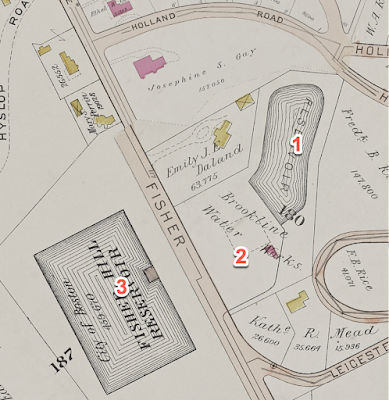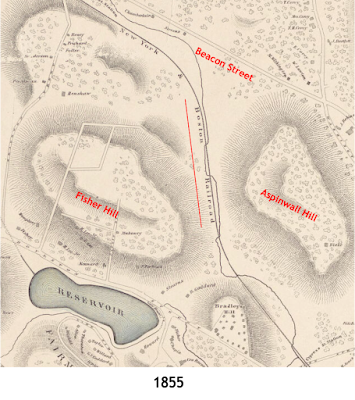The May 6, 1882 edition of the Brookline Chronicle included a list of 33 books recently added to the collection at the Brookline Library. There were books of history, fiction, science, and travel.
There were some how-to books, including two guides for would-be painters: A Course of Lessons in Landscape Painting in Oils and Easy Studies in Water-Color Painting.
There was also a how-to book on a relatively new and increasingly popular art form: photography.
"A Sensible Craze"
"Anyone who has undertaken to be his own photographer will tell you there is a great infatuation about it," noted a review of the book in another newspaper.
"Hence it may be termed a craze," continued the review. "It is also a high art to be able to catch and preserve any little scene of beauty that one may chance to meet with on his summer vacation. Any true art is sensible, therefore amateur photography is a sensible craze."
A year later, the Brookline Chronicle reprinted a lengthy article on "Amateur Photography" from the New York paper The Hour. "The amusement and services that may be had at the cost of a small, cheap photographic outfit are almost numberless," it said.
"Expression, which is the life of a portrait, cannot always be assumed to order in a studio, except by persons whose features are under unusual control, while children's pictures are generally of the variety known as 'wooden.'
"But at home every expression of countenance may be seen and caught. Poses that do not come willingly amid unfamiliar surroundings and before strange observers, succeed each other rapidly in the unrestraining atmosphere of the family circle."
Technical Innovation and the Boston Camera Club
The growth of amateur photography was spurred by the technical innovations of George Eastman and Henry Strong in Rochester, NY, beginning with dry emulsion glass plates in 1880. Camera clubs and photographic societies, taking advantage of the new, less complicated method of developing photos, sprung up across the country, including in Boston.
The Boston Society of Amateur Photographers was formed in 1881. Five years later, the name was changed to the Boston Camera Club.
 |
| Click on image for larger view |
Among the early members of the club were several Brookline men, including James Codman (one of the founders), William Hovey, George E. Cabot, John Hubbard, Robert Amory, Percival Lowell, and Edward Philbrick.
.jpg) |
| This 1886 photo of Cora Codman, age 12, may have been taken by her father, James, one of the founders of the Boston Camera Club. It is one of more than 40 photos of Brookline and Boston children in an album in the collection of the Brookline Historical Society. |
The
Boston Camera Club is the second-oldest continuously extant amateur camera club in the United States. Headquartered in Boston for most of its existence, it was based in Brookline from 1980 to 2023 before returning to Boston.
The Kodak Camera and the Brookline Camera Club
The next big innovation from Eastman in Rochester -- the Kodak camera -- had a big impact on the growth of amateur photography, including in Brookline. .
 |
| Kodak advertisement, Rochester, NY, August 1888 |
The Kodak did away with glass plates altogether. The photographer could shoot multiple images without reloading, then send the film to Rochester to be developed, with the finished images shipped back to the sender when they were done.
In 1891, the Brookline Chronicle ran an article about effective advertising, reprinted from the Milwaukee Journal. One of the most effective ad slogans the article cited was Kodal's "You press the button, we do the rest."
 |
| 1889 Kodak advertisement |
In October 1889, it was announced in the Chronicle that a meeting would be held to form a Brookline Camera Club.
"It is desired that all interested in this most fascinating art be present. The object of the club is for social intercourse and the interchange of views, and there are a sufficient number of photographers here to make it a success."
"Amateurs of both sexes are invited," reported the Brookline Chronicle, adding that "the club's constitution provides that "two of the members of the executive committee shall be ladies." The club was also looking into setting up a darkroom and studio for its members. The club held exhibitions, discussions, and other events in town.
C.A. Chandler, who wrote about photography for the Boston Globe, had noted the creation of the Brookline club in his column. But he was not a fan of amateur photography.
"'Amateur' in its original meaning," he wrote, "is 'a lover of,' and as applied to photography would convey that the man to whom it was applied was an enthusiastic lover of, and consequently a skilled adept in, the art.
"Now," he continued, "the meaning is degraded, and the man who buys a detective [a generic name for some 1880s box cameras], presses the button, and sends his paper or plates to be developed and printed from, is an amateur. He knows no more of the art than does the organ-blower [the person who pumped the air into pre-electric pipe organs] know of music."
Chandler's criticism notwithstanding, amateur photography continued to grow in popularity with men and women, young and old, including in Brookline, even as professionals came to town.
 |
| Brookline Chronicle brief, January 4, 1890 |
Next up: Professional photographers in Brookline into the 20th century. See also the first article in this series:
Brookline Photographers: The Early Years.





































.jpg)




















